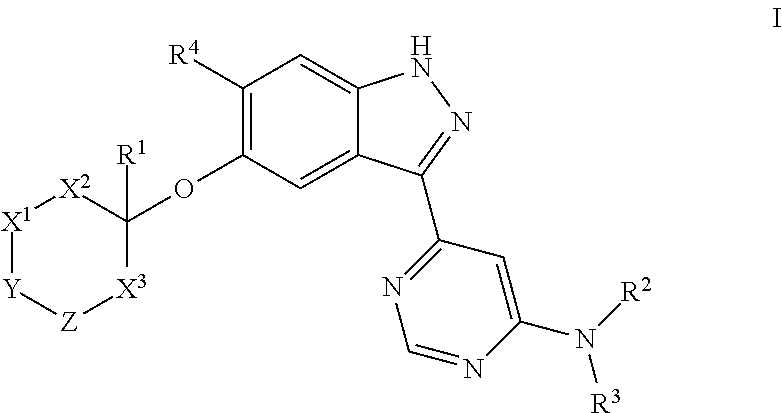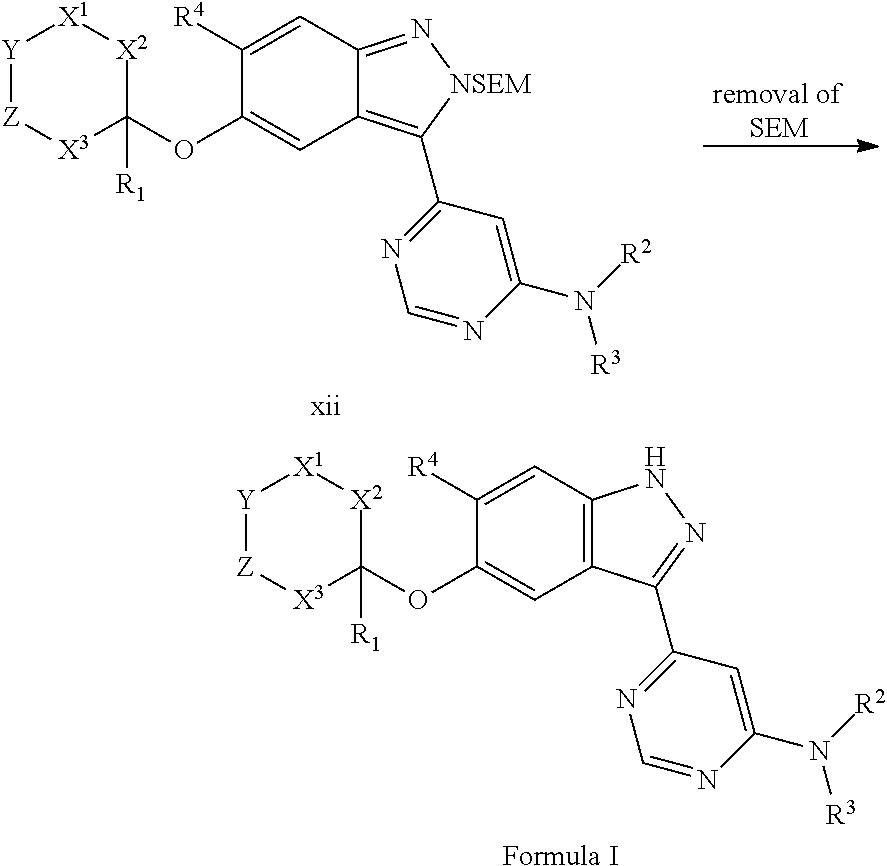Compounds inhibiting leucine-rich repeat kinase enzyme activity
a technology of repeat kinase and compound, which is applied in the field of compound inhibiting leucinerich repeat kinase enzyme activity, can solve the problems that affect the quality of life of patients, and achieve the effect of being useful in treatment or prevention
- Summary
- Abstract
- Description
- Claims
- Application Information
AI Technical Summary
Benefits of technology
Problems solved by technology
Method used
Image
Examples
example 202
[0275]
Step 1:
[0276]A mixture of L-(−)-malic acid (134 g) in 400 ml acetyl chloride was stirred at reflux for 5 h. The reaction mixture was cooled to room temperature and concentrated under reduced pressure to yield a residue which was directly used in the next step without further purification.
Step 2:
[0277]To a solution of compound from Step 1 (˜1 mol) in DCM (2 L) was added BnNH2 (350 mL) dropwise. After being stirred at rt overnight, acetyl chloride (350 mL) was added dropwise. The reaction was stirred at reflux for 5 h. The mixture was cooled to room temperature and concentrated under reduced pressure to yield a residue which was diluted with EtOAc and water. The organic layer was separated and the aqueous layer was extracted with EtOAc (×2). The combined organic layers were dried, filtered and concentrated under reduced pressure to leave residue which was purified by column chromatography on silica gel (elution with 3:1 petroleum ether:EtOAc) to afford the desired product.
Step 3...
example r2
[0312]
Step 1:
[0313]To a cold (0° C.), stirred solution of alcohol (850 mg, 1.661 mmol) in DCM (5.5 mL) was added pyridine (134 μl, 1.661 mmol) followed by Dess-Martin Periodinane (740 mg, 1.744 mmol). The reaction mixture was slowly warmed to room temperature and stirred overnight. The reaction was quenched with a saturated aqueous solution of Na2S2O3 and the resultant mixture was extracted with DCM (×3). The combined organic layers were dried over MgSO4, filtered, and concentrated under reduced pressure to leave a residue which was used directly in the next step without further purification.
Step 2:
[0314]To a cold (0° C.), stirred solution of above aldehyde in THF (10.5 mL) was added MeMgBr (2.1 mL of 3.0 M solution in diethylether, 6.28 mmol) dropwise over 5 min. After being stirred at room temperature overnight, the reaction was quenched with a saturated aqueous solution of NH4Cl and the resulting layer was extracted with EtOAc (×3). The combined organic layers were dried over MgS...
example t2
[0320]
Step 1
[0321]The hydrogenation was carried out using similar method described in step 1 of Scheme T to provide the dimethylpiperazine intermediate.
Step 2
[0322]To a stirred solution of above dimethylpiperazine (370 mg, 0.727 mmol) in DCM (7.3 mL) was added Et3N (203 μl, 1.455 mmol) followed by MeSO2Cl (68.0 μl, 0.873 mmol). After being stirred at room temperature for 18 h the reaction was quenched with a saturated aqueous solution of NaHCO3 and the resultant mixture was extracted DCM (×3). The combined organic layers were dried over MgSO4, filtered, and concentrated under reduced pressure to leave a residue which was purified by flash chromatography on silica (elution with 5:1 DCM:MeOH) to afford the desired product as a light brown oil.
Step 3
[0323]Example U1 was prepared by the removal of SEM group as described by method 2 in Scheme A. LCMS 457.3 [M+1]+ (ret. time=0.97 min, condition A). LRRK2 IC50: 5.2 nM.
TABLE ULRRK2LCMS DataIC50RTExStructure(nM)m / z(min)MethodU21.18443.20.92A...
PUM
| Property | Measurement | Unit |
|---|---|---|
| Pharmaceutically acceptable | aaaaa | aaaaa |
Abstract
Description
Claims
Application Information
 Login to View More
Login to View More - R&D
- Intellectual Property
- Life Sciences
- Materials
- Tech Scout
- Unparalleled Data Quality
- Higher Quality Content
- 60% Fewer Hallucinations
Browse by: Latest US Patents, China's latest patents, Technical Efficacy Thesaurus, Application Domain, Technology Topic, Popular Technical Reports.
© 2025 PatSnap. All rights reserved.Legal|Privacy policy|Modern Slavery Act Transparency Statement|Sitemap|About US| Contact US: help@patsnap.com



